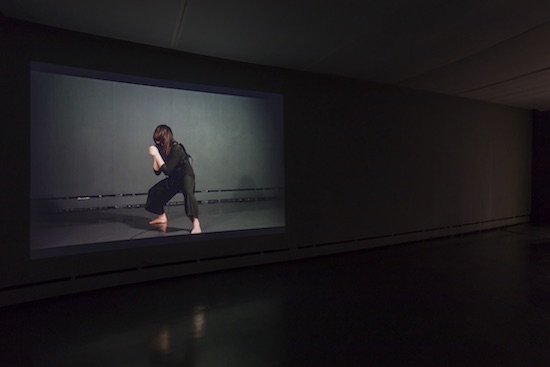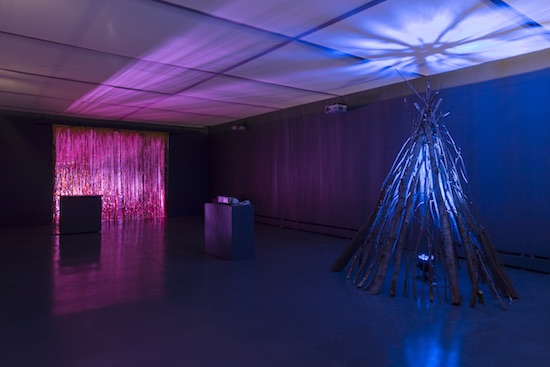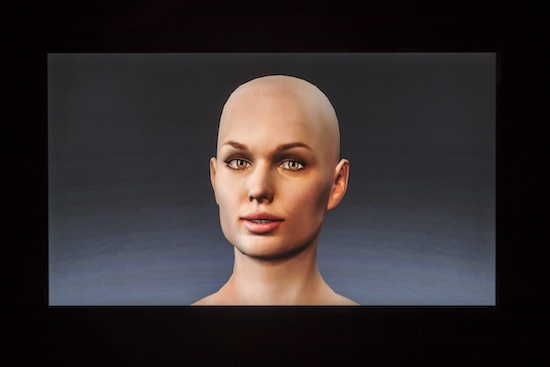“I am not a statue. Statues remain the same even when a bird shits on them … I am telling you different stories, not colossal statuesque truths.” These words, spoken by a computer voice synthesizer somewhere in the midst of Henna-Riikka Halonen’s delirious meditation on AI and artificial flesh, Placeholder (2017), could just as well speak for all the works in Wysing Arts Centre’s present show – or even for the state of contemporary art today, in general.
Featuring eight new time-based works, all produced during Wysing’s residency programme and housed in a small gallery that feels strangely like one of the game rooms in The Crystal Maze, All Channels Open is at once a sort of puzzle – leading you by a thread from one work to the next, teasing you towards its links and implications – and a manifesto – putting forth theses and proffering alternative realities. Like good science fiction, the show becomes a machine for estranging space and time.
As I step into the room, the lights are off. Everything is in darkness. In a flash, an image shoots upon the wall, taking up one third of its surface. Simultaneously, a throb of analogue bass. The projected picture depicts a black device, like a harness or a jetpack, lying prone on a floor that could be the floor of the room I am in right now (in fact, it is). A dusting of small white crystals – sugar – dances on its surface, bouncing up and down in time to the pulsing sound.
Cut. We are closer up now. A hand, with orange-painted fingernails, rests on the surface of the device. Like the sugar, the fingers of this hand jerk and gyre, animated by the vibrations of the device itself as it responds to the acoustic signal.
Cut. A woman – the artist, Florence Peake, though we cannot see her face – is now wearing the device over her chest. She jerks, flexing her body, as if puppeteered by the music generated by Beatrice Dillon’s (unseen) Minimoog. I think of the stiff-limbed dance of E.T.A. Hoffmann’s Olympia.
The device in question is called a Subpac, a “wearable technology that pulses sound through your body.” According to the copy on the company website, it is a “full body experience designed for professionals, made for you. Once you feel sound,” it insists, “you won’t go back to just hearing it.” A slightly worrying statement, if ever I heard one. Vice have called it “the future of music listening.” If the promotional bumf is to be believed, it could be the end of music listening and the beginning of a world closer to that envisioned by J.G. Ballard in his short story ‘The Sound Sweep’ in which an ageing opera singer laments a newly hegemonic taste for infrasonic music.
Cut.
The wall goes black once more.
Another work commences.

One of the peculiarities of All Channels Open is the way it unfolds not through space, but through time. As an exhibition of time-based works (sound, video, performance), this may seem obvious. But one only need think of last year’s Infinite Mix show at the Strand Store or the difficulties major art institutions continue to come up against when dealing with audio-visual works, to appreciate the originality of the conceit. Infinite Mix took advantage of its vast, cavernous space to separate each film spatially in its own cinema-like space, into which visitors could enter as they please, pause for as long as they chose, and move on when they felt like it, walking sometimes for several minutes through concrete corridors to the next work in order to make sure no sound would leak from one work to the next. All Channels Open, by contrast, works more like a mixtape or a DJ set.
These are the kind of terms which curator John Bloomfield used to describe the structure of the exhibition. When choosing the ordering and sequencing of the work, decisions, he said, were made on a largely “musical” basis, inspired as much by Now… compilations as traditional aesthetic criteria. But if this is a mixtape, it is one into which the visitor is immersed and through which they are themselves channeled, led by a schedule that pre-exists them.
Helpfully, this schedule is printed on A4 sheets available at the entrance, so you know, for instance, that Untitled (2017), a collaboration between Florence Peak, Beatrice Dillon, and Anne Tetzlaff, will last just four minutes before being succeeded, for seven minutes, by Laura O’Neil’s In All Sincerity Said The Chicken To The Egg (2017), a surreal computer animation in which Trump-faced balloons and CG potato men occupy a digital landscape at once rural and high-tech, soundtracked by shimmering backwards orchestrations and crisp electronic beats.
And we know, too, that from the small screen at the far end of the room where this film plays, our focus will next be directed to a sculpture and sound work occupying the near corner, David Blandy and Larry Achiampong’s Finding Fanon 3: First Movement.

Over the last two years, the Finding Fanon series has looked at the lost plays of Martinique-born psychiatrist and critical theorist Frantz Fanon. Achiampong and Blandy’s aim, throughout has been to examine, as they say, “the politics of race, racism and decolonisation, and how these societal issues affect our relationship amidst an age of new technology, popular culture and globalisation.” Previous instalments have found Blandy and Achiampong swapping stories of race and colonialism, in three-piece tweed suits, by the English seaside, or racing through barren streets, courtesy of the in-game video editor on Grand Theft Auto 5.
The new work Blandy described to me as “an experiment in creating an audio-only branch of the series, emphasising the synth compositions and script work that Larry and I have made together.” As the light changes in the gallery once more, I found my sight directed towards a wigwam of gathered branches with a blue stage light in the middle, facing up. “Technology has confused everything,” the voice-over by Hayleigh-Joy Rose intones over a shimmer of analogue electronics and a putter of sequenced bass. “What happens when two neutron stars collide? A new black hole. The universe sucked into its own event horizon.” In contrast to the rural image presented by the tent-like structure, the light shining through the wood paints onto the ceiling an image like starbursts, distant galaxies erupting.
The room shifts again, becoming in a moment another time, another space, confirming Wysing director Donna Lynas’s hint to me, before I went in, that this show was less like a group show, more like eight solo shows, one after the after.
For Evan Ifekoya’s Scenario One: The Ice Box (2017), the gallery becomes a futuristic club space, the light from two pink LED strip lights shimmering through a curtain of tasseled silver and gold hanging over the entrance way. “The year is 2067. At the Ice Box, everything has changed…” The voice that speaks is soaked in echo, almost to the point of unintelligibility. The narrative drifts woozily between romantic reverie and futuristic anticipation. This is storytelling as dub science and sonic fiction.
When I interviewed Lawrence Lek last summer, he talked about “making virtual worlds” as “loose critiques of neoliberal regeneration” and “continuous strange documentaries of the places I’m based in.” His new work for Wysing extends and develops this project in several surprising directions at once. It takes the form, most immediately, of an architectural maquette of the nightclub Fabric. Embedded within this scale model, however, are two small screens which show a video lecture on the subject of ‘Sinofuturism’.
“Sinofuturism,” the voiceover explains, “is an invisible movement, a spectre already embedded in products … arisen without intention or authorship. A science fiction that already exists.”
Reaching out to Lek via email, I asked him how this new work relates to the ‘Bonus Levels’ we discussed last year. “Since all the site-specific stuff,” he replied, “in the last year I’ve made a few films about fictional artists. So the set/scenography and the persona/identity of the ‘first-person’ viewer are more intertwined. Whereas in the earlier Bonus Levels stuff, it’s more assumed that the first-person viewer is the audience, now it’s more ambiguous whether it’s the audience or the narrator.” Which leads me to wonder: is this little Fabric we see before us – here dubbed ‘Fabrick’, as a nod to the subtle (and sometimes not-so-subtle) rebranding that takes place with Chinese imitation goods – itself the work of a fictional artist? Perhaps one of the artificial intelligences discussed in the video essay…?
Combining video, sound, and sculpture, All Channels Open is an exhibition which manages to feel like a work itself – a piece of music, perhaps, but a piece of music one can walk around in. Throughout the time I spent in the gallery, I found myself led one way or another, my body pushed and animated in various directions by the light and sound existing in the space – an experience, perhaps, not unlike wearing a Subpac, puppeteered by electronic forces outside of one’s own control.
Wysing Arts Centre until 26 March


